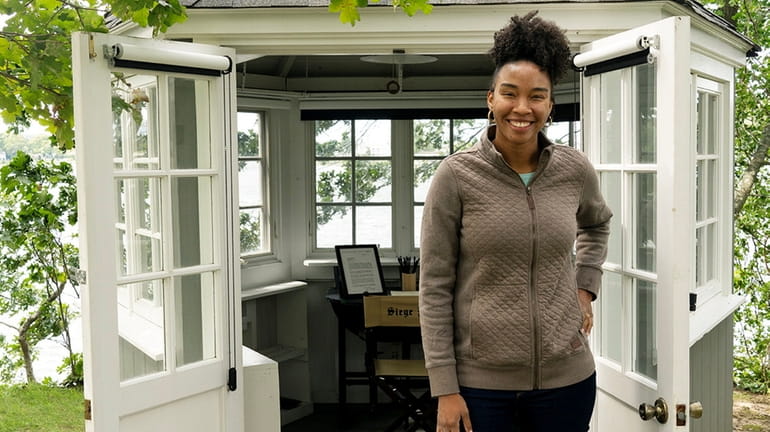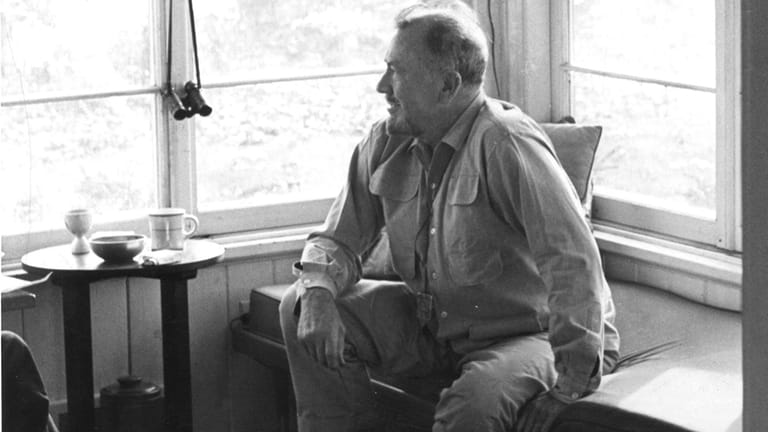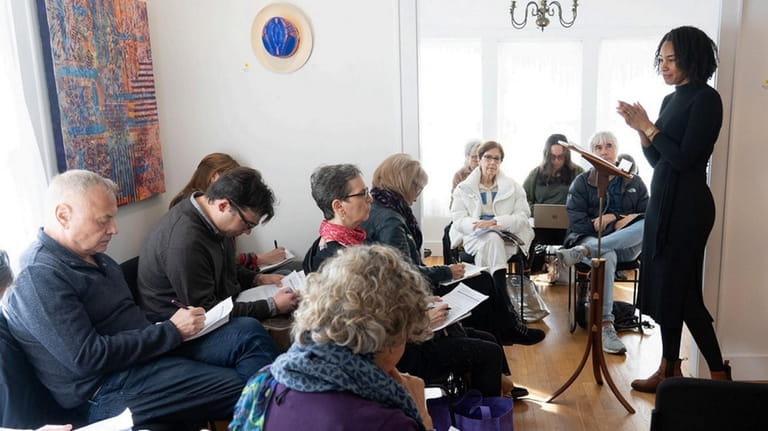This lucky writer lived at John Steinbeck's Sag Harbor home, and she's sharing details

Aspiring novelist Carrie R. Moore at the hexagonal hut where John Steinbeck wrote his last two books. Credit: Kathryn Szoka
In the bright sunroom of the Sag Harbor cottage John Steinbeck called home, aspiring novelist Carrie R. Moore marveled each morning at the view.
From her corner desk, she gazed out at Morris Cove, where light reflecting off the water created a scene that could nearly lull her to sleep.
To her right, she could see the hexagonal writing studio where six decades earlier Steinbeck crafted his final novels, “Travels with Charley: In Search of America” and “The Winter of Our Discontent.”
Moore spent 2½ months in the personal space of the Pulitzer Prize and Nobel Prize-winning author in fall while completing a draft of her debut novel, “Clarity.” She was the first writer-in-residence at the recently preserved Steinbeck home.
The new Steinbeck Writers’ Retreat in Sag Harbor aims to continue the novelist’s legacy by providing first-time authors time and space to hone their craft in autumn in the waterfront village that adopted the California native as one of its own. A similar summer fellowship will support a writer at the top of his or her career.
“No writer was as immersed in Sag Harbor’s life as John Steinbeck,” said Kathryn Szoka, who spearheaded the home’s preservation and co-owns Canio’s Books in Sag Harbor.
In an exclusive Newsday interview, Moore shared her experience of living in what she described as a “cozy” cottage, including details of her daily routine and how she has drawn inspiration from one of America’s most renowned writers.
Southampton Town, in collaboration with the nonprofit Sag Harbor Partnership, purchased the cottage in early 2023 from the Elaine Steinbeck Trust to preserve it for future generations. The 1,200-square-foot home Steinbeck bought in 1955 was listed for sale in 2021, sparking fears its history could be lost.
Part of the aim of establishing a fellowship program for writers at the cottage was to build on Steinbeck’s legacy of helping novice authors.
When he won the Pulitzer Prize for his 1939 classic, “The Grapes of Wrath,” he donated his $1,000 prize money to an aspiring novelist. When that money ran out, Steinbeck opened his home to the writer so he could keep working, Szoka said.
The Michener Center for Writers at the University of Texas at Austin welcomed the opportunity to lead the writer’s residency program at the request of the town and Sag Harbor Partnership. Steinbeck’s late widow, Elaine Steinbeck, studied theater at the university.
Moore, 30, arrived in Sag Harbor in September, about six weeks after learning a Michener Center committee unanimously selected her as the first fellowship recipient.
“I was pretty shocked,” she said.
Moore, an Atlanta native who lives in Austin, Texas, earned a graduate degree from the program and won the university’s $50,000 Keene Prize for Literature award in 2021 for her story “The Rest of the Morning.”
The writer said she expected a “sort of ghostly Steinbeck presence” hovering throughout her stay. But that wasn't the case.
While the house's interior largely has been renovated since Steinbeck’s era — he died in 1968, and his wife died in 2003 — only some traces of the author remain. In the den, there is a bird mobile Steinbeck built, she said, as well as a game of ring toss.
“It’s a beautiful property with lots of history surrounding it,” Moore said, “but it didn’t feel haunted — in a good way.”
Moore read several books during her stay, including “Travels with Charley,” about Steinbeck’s journey across America with his French poodle, Charley.
She said it “was very cool to be sitting in the sunroom” reading the book and looking out and seeing the garage where Steinbeck parked the pickup truck he wrote about in the book.
Moore spent her days writing from about 8 a.m. to 1 p.m. She’d break for lunch and walk into the village, stopping at a coffee shop, bookstore or the library.
She’d often meet people along the way and spark up a conversation.
“We all benefited from her presence here,” said Maryann Calendrille, who co-owns Canio Books with Szoka.
“Her sensitivity and maturity and insightfulness is beyond her age,” Szoka said. “As her writing is, too.”
While Steinbeck wrote in the hexagonal studio he called Joyous Garde, Moore preferred using the sunroom to keep all her writing material in one spot.
The Steinbeck property was open to tours at select weekend times by reservation, so guests got to peek inside the studio — but not the cottage — during her stay.
Moore wouldn't let even her husband, Jonathan Wilson, a lawyer who stayed with her in Sag Harbor while working remotely, near her papers as she worked.
Elaine Steinbeck described the studio in a 1971 Newsday interview as a place her husband designed in order to work free of distractions.
“I never went out there unless I was asked,” she recalled.
In his later years while he lived in Sag Harbor, Steinbeck also worked as a correspondent for Newsday covering the Vietnam War. His series of columns called “Letters to Alicia” began publishing in December 1966 in a Saturday magazine called “Weekend With Newsday.”
Like Steinbeck did, Moore writes in longhand. She prefers Leuchtturm1917 notebooks and fountain pens.
Moore said she draws inspiration from the way Steinbeck wrote about setting and place with “really deep observations.” For Steinbeck, that place often was his native California. For Moore, it’s the South.
While in Sag Harbor, she filled 3½ notebooks with her latest draft of a novel set in an all-Black town of glassmakers. Moore’s interest in exploring Sag Harbor’s historically Black beach communities that were borne out of discrimination impressed the committee that selected her, according to Bret Anthony Johnston, the Michener Center's director.
He said Moore’s work is “in many ways in conversation with the work that John Steinbeck was doing in Sag Harbor” because her writing also delves into cultural inequities.
With her draft now in her literary agent’s hands, Moore said she'll hear soon if more revisions are needed or if it’s time to shop the book to publishers.
“And when it comes out, it’ll be in no small part because of the work she did there,” Johnston said of the place Steinbeck called home.
In the bright sunroom of the Sag Harbor cottage John Steinbeck called home, aspiring novelist Carrie R. Moore marveled each morning at the view.
From her corner desk, she gazed out at Morris Cove, where light reflecting off the water created a scene that could nearly lull her to sleep.
To her right, she could see the hexagonal writing studio where six decades earlier Steinbeck crafted his final novels, “Travels with Charley: In Search of America” and “The Winter of Our Discontent.”
Moore spent 2½ months in the personal space of the Pulitzer Prize and Nobel Prize-winning author in fall while completing a draft of her debut novel, “Clarity.” She was the first writer-in-residence at the recently preserved Steinbeck home.
The new Steinbeck Writers’ Retreat in Sag Harbor aims to continue the novelist’s legacy by providing first-time authors time and space to hone their craft in autumn in the waterfront village that adopted the California native as one of its own. A similar summer fellowship will support a writer at the top of his or her career.
“No writer was as immersed in Sag Harbor’s life as John Steinbeck,” said Kathryn Szoka, who spearheaded the home’s preservation and co-owns Canio’s Books in Sag Harbor.
In an exclusive Newsday interview, Moore shared her experience of living in what she described as a “cozy” cottage, including details of her daily routine and how she has drawn inspiration from one of America’s most renowned writers.
Writing legacy
Southampton Town, in collaboration with the nonprofit Sag Harbor Partnership, purchased the cottage in early 2023 from the Elaine Steinbeck Trust to preserve it for future generations. The 1,200-square-foot home Steinbeck bought in 1955 was listed for sale in 2021, sparking fears its history could be lost.
Part of the aim of establishing a fellowship program for writers at the cottage was to build on Steinbeck’s legacy of helping novice authors.
When he won the Pulitzer Prize for his 1939 classic, “The Grapes of Wrath,” he donated his $1,000 prize money to an aspiring novelist. When that money ran out, Steinbeck opened his home to the writer so he could keep working, Szoka said.

John Steinbeck admires the view from the sun porch of his Sag Harbor home on Nov. 5, 1962. Credit: Newsday/Max Heine
The Michener Center for Writers at the University of Texas at Austin welcomed the opportunity to lead the writer’s residency program at the request of the town and Sag Harbor Partnership. Steinbeck’s late widow, Elaine Steinbeck, studied theater at the university.
Moore, 30, arrived in Sag Harbor in September, about six weeks after learning a Michener Center committee unanimously selected her as the first fellowship recipient.
“I was pretty shocked,” she said.
Moore, an Atlanta native who lives in Austin, Texas, earned a graduate degree from the program and won the university’s $50,000 Keene Prize for Literature award in 2021 for her story “The Rest of the Morning.”
The writer said she expected a “sort of ghostly Steinbeck presence” hovering throughout her stay. But that wasn't the case.
While the house's interior largely has been renovated since Steinbeck’s era — he died in 1968, and his wife died in 2003 — only some traces of the author remain. In the den, there is a bird mobile Steinbeck built, she said, as well as a game of ring toss.
“It’s a beautiful property with lots of history surrounding it,” Moore said, “but it didn’t feel haunted — in a good way.”
Moore read several books during her stay, including “Travels with Charley,” about Steinbeck’s journey across America with his French poodle, Charley.
She said it “was very cool to be sitting in the sunroom” reading the book and looking out and seeing the garage where Steinbeck parked the pickup truck he wrote about in the book.
Longhand and fountain pens
Moore spent her days writing from about 8 a.m. to 1 p.m. She’d break for lunch and walk into the village, stopping at a coffee shop, bookstore or the library.
She’d often meet people along the way and spark up a conversation.
“We all benefited from her presence here,” said Maryann Calendrille, who co-owns Canio Books with Szoka.
“Her sensitivity and maturity and insightfulness is beyond her age,” Szoka said. “As her writing is, too.”
While Steinbeck wrote in the hexagonal studio he called Joyous Garde, Moore preferred using the sunroom to keep all her writing material in one spot.
The Steinbeck property was open to tours at select weekend times by reservation, so guests got to peek inside the studio — but not the cottage — during her stay.
Moore wouldn't let even her husband, Jonathan Wilson, a lawyer who stayed with her in Sag Harbor while working remotely, near her papers as she worked.
Elaine Steinbeck described the studio in a 1971 Newsday interview as a place her husband designed in order to work free of distractions.
“I never went out there unless I was asked,” she recalled.
In his later years while he lived in Sag Harbor, Steinbeck also worked as a correspondent for Newsday covering the Vietnam War. His series of columns called “Letters to Alicia” began publishing in December 1966 in a Saturday magazine called “Weekend With Newsday.”

Writer Carrie R. Moore leads a writing workshop in November at Sag Harbor's Eastville Community Historical Society. Credit: Kathryn Szoka
Like Steinbeck did, Moore writes in longhand. She prefers Leuchtturm1917 notebooks and fountain pens.
Moore said she draws inspiration from the way Steinbeck wrote about setting and place with “really deep observations.” For Steinbeck, that place often was his native California. For Moore, it’s the South.
While in Sag Harbor, she filled 3½ notebooks with her latest draft of a novel set in an all-Black town of glassmakers. Moore’s interest in exploring Sag Harbor’s historically Black beach communities that were borne out of discrimination impressed the committee that selected her, according to Bret Anthony Johnston, the Michener Center's director.
He said Moore’s work is “in many ways in conversation with the work that John Steinbeck was doing in Sag Harbor” because her writing also delves into cultural inequities.
With her draft now in her literary agent’s hands, Moore said she'll hear soon if more revisions are needed or if it’s time to shop the book to publishers.
“And when it comes out, it’ll be in no small part because of the work she did there,” Johnston said of the place Steinbeck called home.

